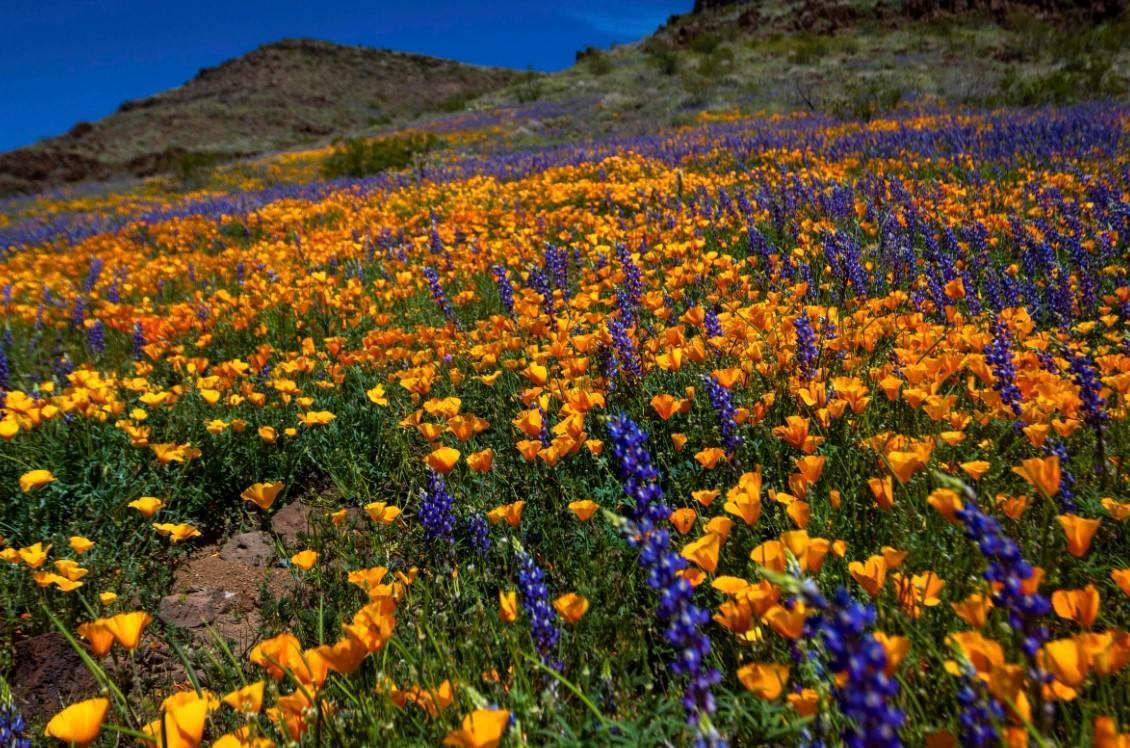
An explosion of oranges, yellows, purples and whites has covered California’s hillsides, as a rare “super bloom” bursts into life in the wake of a very wet winter.
Vast stretches of countryside that spend months of the year as a muted, dry brown have been transformed into a carpet of color that can be seen from space.
“It almost feels like a painting,” says Triana Montserrat as she surveys the California poppies, brittlebush and lupins that smother the ground.
“It’s so intricate, and it’s so beautiful. It’s like my mind couldn’t even have come up with that itself,” adds the 29-year-old.
America’s most populous state spent months cowering from the onslaught of repeated storms that brought near-record rainfall.
Californians more used to wearing shorts and shades retreated indoors, where many suddenly discovered roof leaks that had gone unnoticed during several dry years.
But as the waterlogged winter gave way to spring, nature revealed its spectacular reward.
Behold: The super bloom, an ill-defined but you’ll-know-it-when-you-see-it treat that comes along every so often, when the arid ground is treated to a jolly good soaking.
From the earliest Spanish missionaries to some of the giants of American literature, the super bloom has long captivated those lucky enough to see it.
Unfortunately, say nature lovers, the era of Instagram and TikTok means these delicate blooms can easily become victims of their own popularity.
A short distance from where AFP visited, a hiking trail is closed to the public to avoid being swamped.
The neighboring town of Lake Elsinore has shut the gates on Walker Canyon, with a patrol car stationed there to make sure no one gets in.
It’s all part of an effort to avoid a repeat of what was dubbed the “poppy apocalypse” of 2019, during the last super bloom, when tens of thousands of daytrippers swarmed the countryside creating monster traffic jams that paralyzed the region.
Influencers and selfie-seeking tourists dumped their cars along highways and marched right into the wildflowers, crushing whatever lay in their path as they sought the perfect shot.
“It was a nightmare. They just trampled over everything, and smashed a lot of the flowers,” says Pete Liston, owner of the Skull Canyon zip line.
“In the area over Walker Canyon, you can still see where in 2019 they made trails. Nothing grew back even in the super bloom.”
His adventure park is capitalizing on 2023’s abundance, offering tours that take riders whizzing above the flowers, where they can enjoy them without fear of killing anything.
For Montserrat, it’s the perfect way to savor the spectacle without leaving a mark on the landscape.
“I’ve always wanted to do the super bloom, to hike through it,” she tells AFP.
“But I wanted to make sure that it was here for future generations to enjoy.”
While most people agree on the need to protect the flowers, not everyone wants to see trails closed with only webcams offered in their place, as Lake Elsinore has done.
Each super bloom is a “moment enabling the public to connect with nature and to grow enthusiasm for California biodiversity,” says Evan Meyer of the Theodore Payne Foundation, an organization highlighting Southern California’s natural flora.
“In closing down Walker Canyon, Lake Elsinore is sending the exact opposite message.”
Instead of stopping people from enjoying these marvelous displays, he says: “We need to develop an ethic of nature appreciation within our culture.”